Abstract
Human tobacco-related cancers exhibit a high frequency of G to T transversions in the mutation hot spot region of the p53 tumor suppressor gene, possibly the result of specific mutagens in tobacco smoke, most notably benzo[a]pyrene (B[a]P). No in vivo animal model of B[a]P-induced tumorigenesis has been used, however, to substantiate these molecular epidemiological data experimentally. Direct DNA sequence analysis of the hot spot region (exons 5-8 inclusive) of murine p53 was performed in 20 skin tumors induced by a complete carcinogenesis protocol with B[a]P. Sequence analyses revealed numerous heterozygous missense mutations in carcinomas, specifically in exons 7 and 8 of the p53 gene, and targeting exclusively guanine residues. Moreover, 70% (5/7) of the mutations characterized were G to T transversions. In contrast, direct DNA sequence analysis of 36 skin tumors induced by 7,12-dimethylbenz[a]anthracene (DMBA) in either a complete carcinogenesis protocol or in a two-stage carcinogenesis protocol revealed a 30% frequency of heterozygous p53 mutations, with the majority of mutations found in carcinomas, but only a single G to T transversion (1/8). Thus, while mutation frequencies are similar, the pattern and type of p53 mutations in B[a]P-induced skin tumors differs significantly from the mutation spectra in DMBA-induced squamous neoplasias. These in vivo findings in B[a]P-induced tumors lend support to in vitro and molecular epidemiological evidence, suggesting that the p53 tumor suppressor gene may be a selective target of metabolically activated B[a]P species etiologically associated with human tobacco-related cancers.
Full text
PDF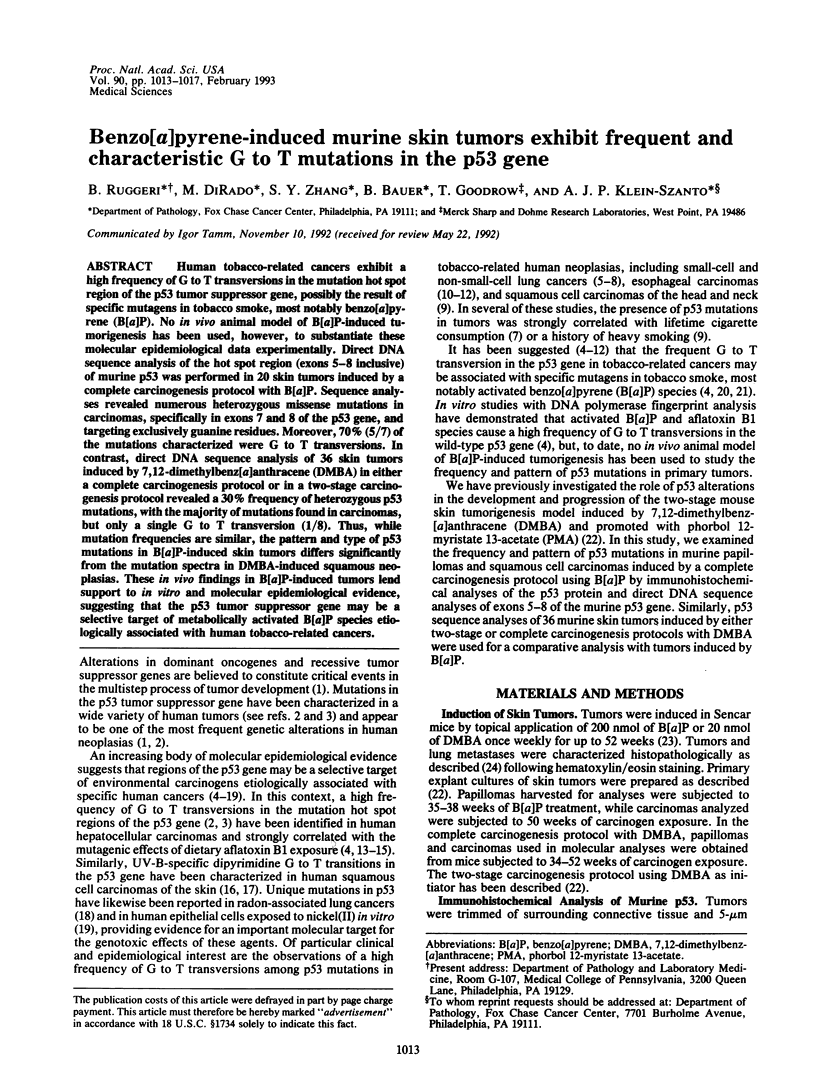
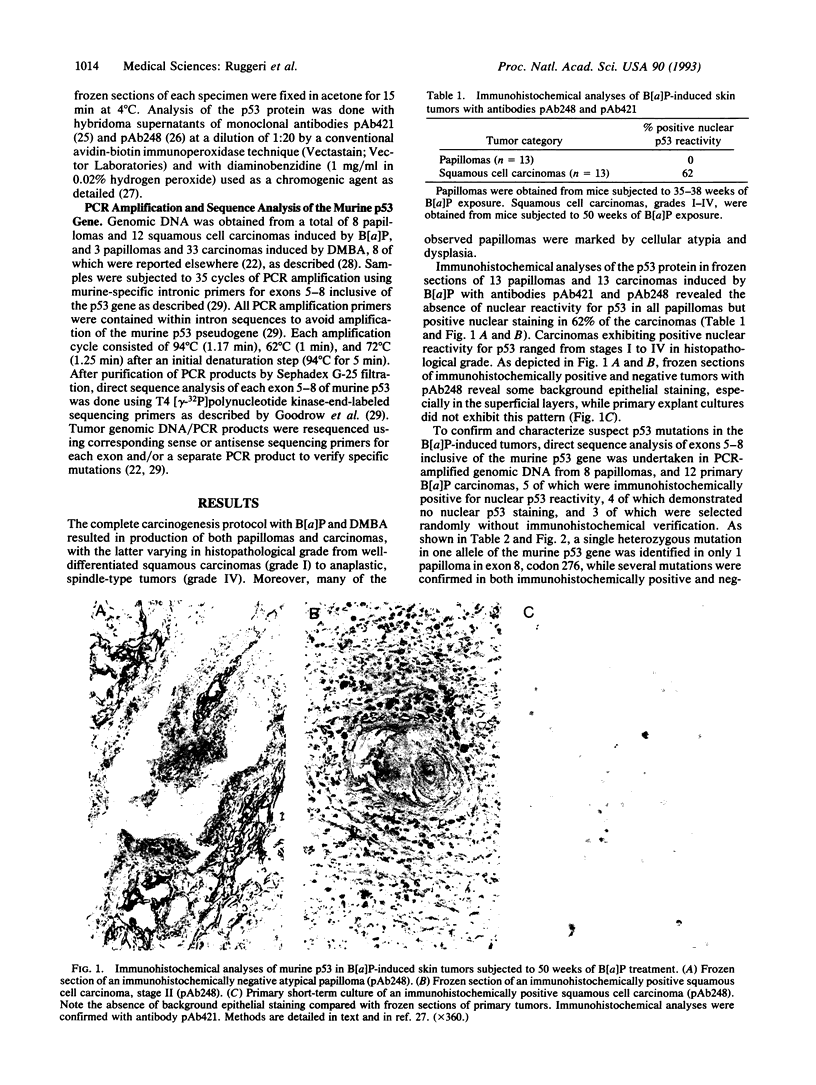
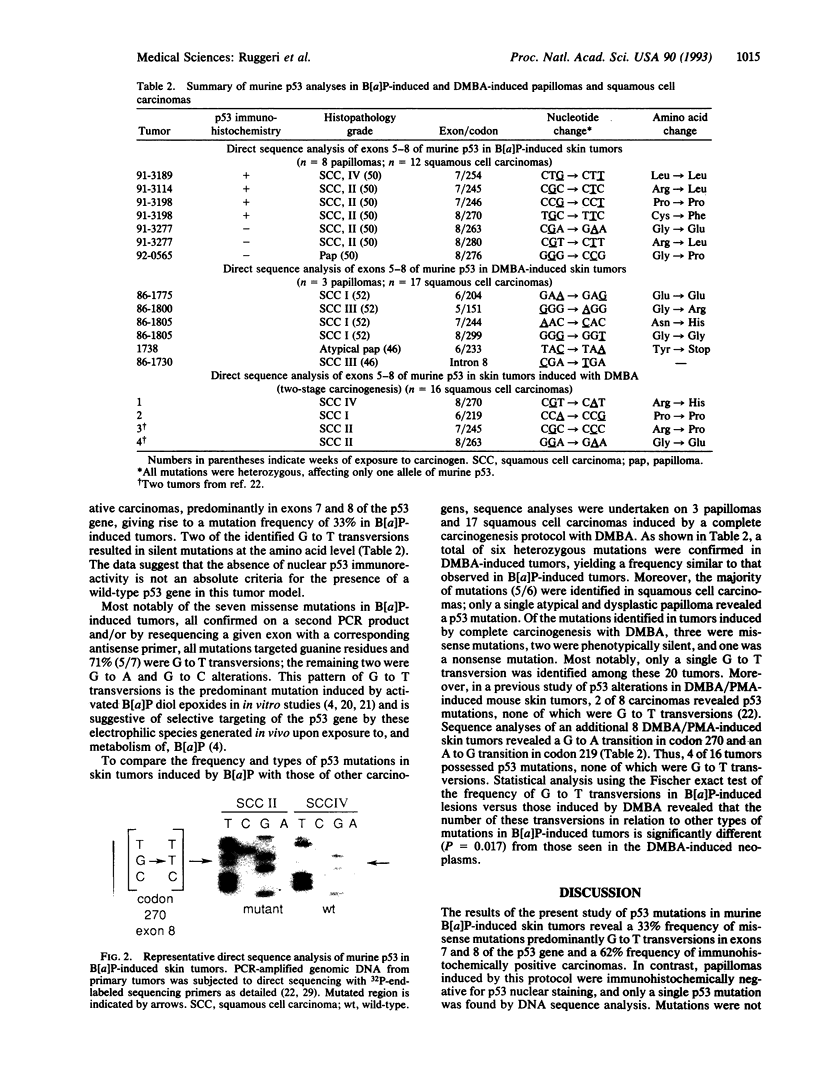
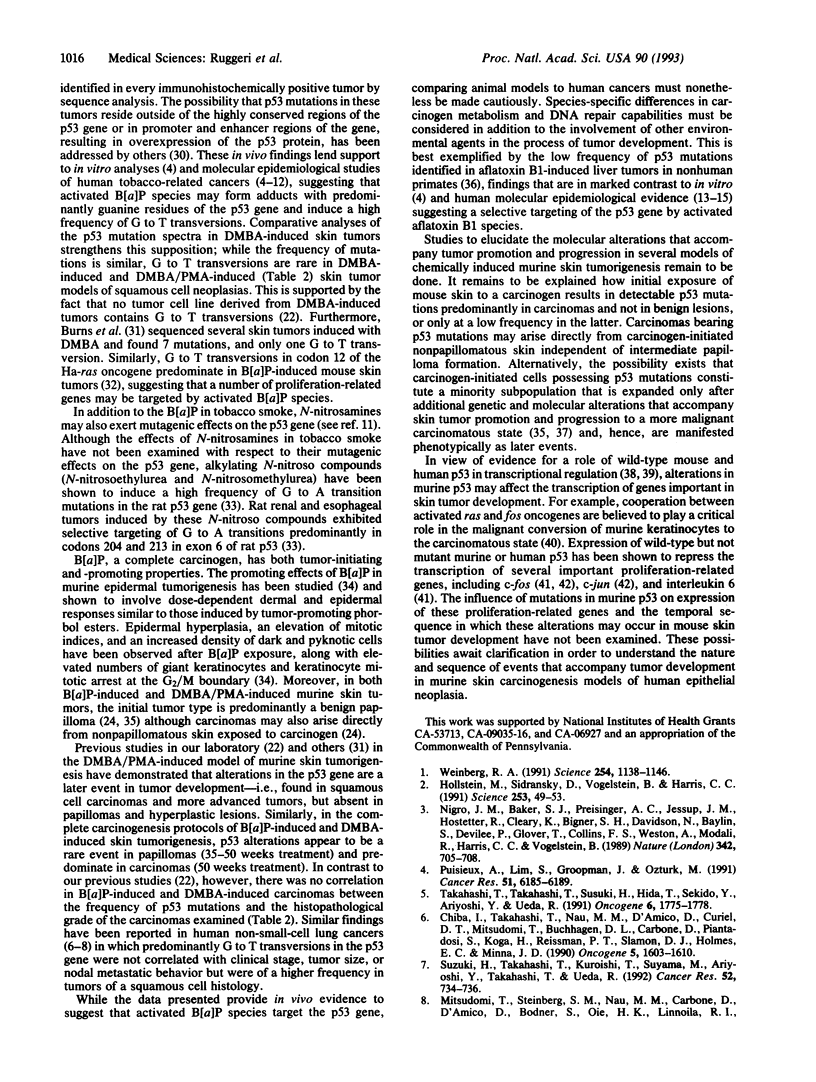
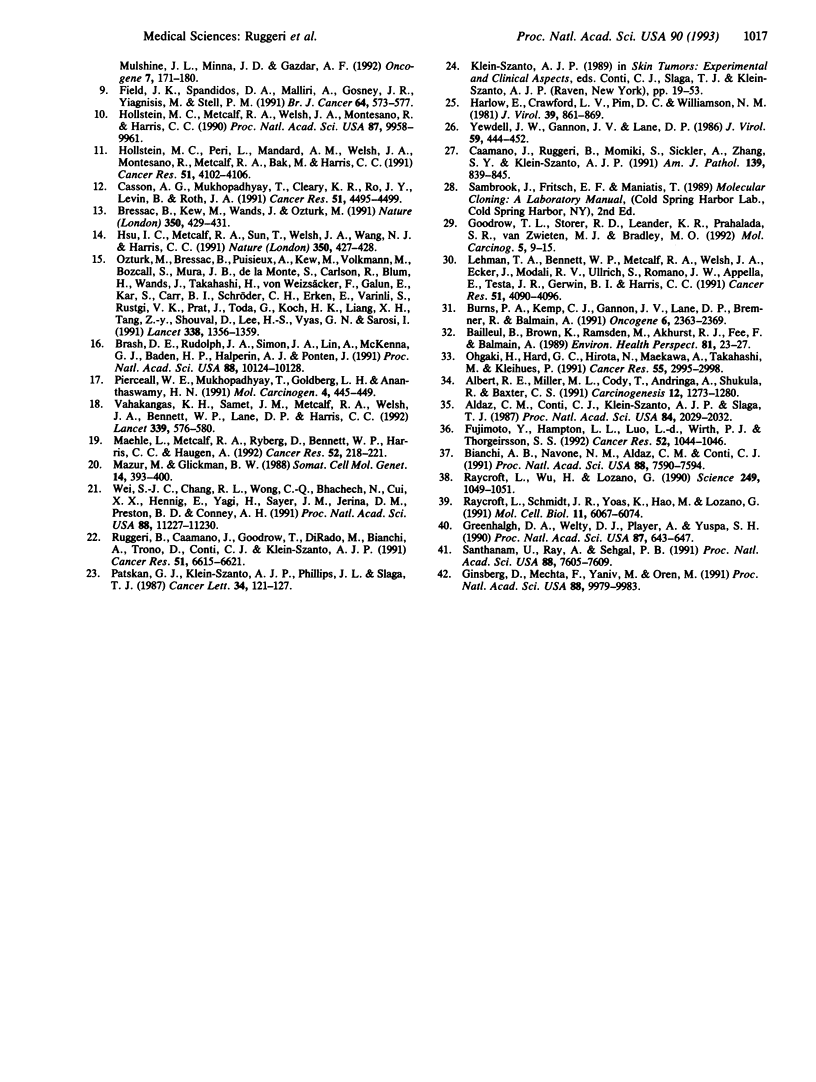
Images in this article
Selected References
These references are in PubMed. This may not be the complete list of references from this article.
- Albert R. E., Miller M. L., Cody T., Andringa A., Shukla R., Baxter C. S. Benzo[a]pyrene-induced skin damage and tumor promotion in the mouse. Carcinogenesis. 1991 Jul;12(7):1273–1280. doi: 10.1093/carcin/12.7.1273. [DOI] [PubMed] [Google Scholar]
- Aldaz C. M., Conti C. J., Klein-Szanto A. J., Slaga T. J. Progressive dysplasia and aneuploidy are hallmarks of mouse skin papillomas: relevance to malignancy. Proc Natl Acad Sci U S A. 1987 Apr;84(7):2029–2032. doi: 10.1073/pnas.84.7.2029. [DOI] [PMC free article] [PubMed] [Google Scholar]
- Bailleul B., Brown K., Ramsden M., Akhurst R. J., Fee F., Balmain A. Chemical induction of oncogene mutations and growth factor activity in mouse skin carcinogenesis. Environ Health Perspect. 1989 May;81:23–27. doi: 10.1289/ehp.898123. [DOI] [PMC free article] [PubMed] [Google Scholar]
- Bianchi A. B., Navone N. M., Aldaz C. M., Conti C. J. Overlapping loss of heterozygosity by mitotic recombination on mouse chromosome 7F1-ter in skin carcinogenesis. Proc Natl Acad Sci U S A. 1991 Sep 1;88(17):7590–7594. doi: 10.1073/pnas.88.17.7590. [DOI] [PMC free article] [PubMed] [Google Scholar]
- Brash D. E., Rudolph J. A., Simon J. A., Lin A., McKenna G. J., Baden H. P., Halperin A. J., Pontén J. A role for sunlight in skin cancer: UV-induced p53 mutations in squamous cell carcinoma. Proc Natl Acad Sci U S A. 1991 Nov 15;88(22):10124–10128. doi: 10.1073/pnas.88.22.10124. [DOI] [PMC free article] [PubMed] [Google Scholar]
- Bressac B., Kew M., Wands J., Ozturk M. Selective G to T mutations of p53 gene in hepatocellular carcinoma from southern Africa. Nature. 1991 Apr 4;350(6317):429–431. doi: 10.1038/350429a0. [DOI] [PubMed] [Google Scholar]
- Burns P. A., Kemp C. J., Gannon J. V., Lane D. P., Bremner R., Balmain A. Loss of heterozygosity and mutational alterations of the p53 gene in skin tumours of interspecific hybrid mice. Oncogene. 1991 Dec;6(12):2363–2369. [PubMed] [Google Scholar]
- Caamano J., Ruggeri B., Momiki S., Sickler A., Zhang S. Y., Klein-Szanto A. J. Detection of p53 in primary lung tumors and nonsmall cell lung carcinoma cell lines. Am J Pathol. 1991 Oct;139(4):839–845. [PMC free article] [PubMed] [Google Scholar]
- Casson A. G., Mukhopadhyay T., Cleary K. R., Ro J. Y., Levin B., Roth J. A. p53 gene mutations in Barrett's epithelium and esophageal cancer. Cancer Res. 1991 Aug 15;51(16):4495–4499. [PubMed] [Google Scholar]
- Chiba I., Takahashi T., Nau M. M., D'Amico D., Curiel D. T., Mitsudomi T., Buchhagen D. L., Carbone D., Piantadosi S., Koga H. Mutations in the p53 gene are frequent in primary, resected non-small cell lung cancer. Lung Cancer Study Group. Oncogene. 1990 Oct;5(10):1603–1610. [PubMed] [Google Scholar]
- Field J. K., Spandidos D. A., Malliri A., Gosney J. R., Yiagnisis M., Stell P. M. Elevated P53 expression correlates with a history of heavy smoking in squamous cell carcinoma of the head and neck. Br J Cancer. 1991 Sep;64(3):573–577. doi: 10.1038/bjc.1991.352. [DOI] [PMC free article] [PubMed] [Google Scholar]
- Fujimoto Y., Hampton L. L., Luo L. D., Wirth P. J., Thorgeirsson S. S. Low frequency of p53 gene mutation in tumors induced by aflatoxin B1 in nonhuman primates. Cancer Res. 1992 Feb 15;52(4):1044–1046. [PubMed] [Google Scholar]
- Ginsberg D., Mechta F., Yaniv M., Oren M. Wild-type p53 can down-modulate the activity of various promoters. Proc Natl Acad Sci U S A. 1991 Nov 15;88(22):9979–9983. doi: 10.1073/pnas.88.22.9979. [DOI] [PMC free article] [PubMed] [Google Scholar]
- Goodrow T. L., Storer R. D., Leander K. R., Prahalada S. R., van Zwieten M. J., Bradley M. O. Murine p53 intron sequences 5-8 and their use in polymerase chain reaction/direct sequencing analysis of p53 mutations in CD-1 mouse liver and lung tumors. Mol Carcinog. 1992;5(1):9–15. doi: 10.1002/mc.2940050105. [DOI] [PubMed] [Google Scholar]
- Greenhalgh D. A., Welty D. J., Player A., Yuspa S. H. Two oncogenes, v-fos and v-ras, cooperate to convert normal keratinocytes to squamous cell carcinoma. Proc Natl Acad Sci U S A. 1990 Jan;87(2):643–647. doi: 10.1073/pnas.87.2.643. [DOI] [PMC free article] [PubMed] [Google Scholar]
- Harlow E., Crawford L. V., Pim D. C., Williamson N. M. Monoclonal antibodies specific for simian virus 40 tumor antigens. J Virol. 1981 Sep;39(3):861–869. doi: 10.1128/jvi.39.3.861-869.1981. [DOI] [PMC free article] [PubMed] [Google Scholar]
- Hollstein M. C., Metcalf R. A., Welsh J. A., Montesano R., Harris C. C. Frequent mutation of the p53 gene in human esophageal cancer. Proc Natl Acad Sci U S A. 1990 Dec;87(24):9958–9961. doi: 10.1073/pnas.87.24.9958. [DOI] [PMC free article] [PubMed] [Google Scholar]
- Hollstein M. C., Peri L., Mandard A. M., Welsh J. A., Montesano R., Metcalf R. A., Bak M., Harris C. C. Genetic analysis of human esophageal tumors from two high incidence geographic areas: frequent p53 base substitutions and absence of ras mutations. Cancer Res. 1991 Aug 1;51(15):4102–4106. [PubMed] [Google Scholar]
- Hollstein M., Sidransky D., Vogelstein B., Harris C. C. p53 mutations in human cancers. Science. 1991 Jul 5;253(5015):49–53. doi: 10.1126/science.1905840. [DOI] [PubMed] [Google Scholar]
- Hsu I. C., Metcalf R. A., Sun T., Welsh J. A., Wang N. J., Harris C. C. Mutational hotspot in the p53 gene in human hepatocellular carcinomas. Nature. 1991 Apr 4;350(6317):427–428. doi: 10.1038/350427a0. [DOI] [PubMed] [Google Scholar]
- Lehman T. A., Bennett W. P., Metcalf R. A., Welsh J. A., Ecker J., Modali R. V., Ullrich S., Romano J. W., Appella E., Testa J. R. p53 mutations, ras mutations, and p53-heat shock 70 protein complexes in human lung carcinoma cell lines. Cancer Res. 1991 Aug 1;51(15):4090–4096. [PubMed] [Google Scholar]
- Maehle L., Metcalf R. A., Ryberg D., Bennett W. P., Harris C. C., Haugen A. Altered p53 gene structure and expression in human epithelial cells after exposure to nickel. Cancer Res. 1992 Jan 1;52(1):218–221. [PubMed] [Google Scholar]
- Mazur M., Glickman B. W. Sequence specificity of mutations induced by benzo[a]pyrene-7,8-diol-9,10-epoxide at endogenous aprt gene in CHO cells. Somat Cell Mol Genet. 1988 Jul;14(4):393–400. doi: 10.1007/BF01534647. [DOI] [PubMed] [Google Scholar]
- Mitsudomi T., Steinberg S. M., Nau M. M., Carbone D., D'Amico D., Bodner S., Oie H. K., Linnoila R. I., Mulshine J. L., Minna J. D. p53 gene mutations in non-small-cell lung cancer cell lines and their correlation with the presence of ras mutations and clinical features. Oncogene. 1992 Jan;7(1):171–180. [PubMed] [Google Scholar]
- Nigro J. M., Baker S. J., Preisinger A. C., Jessup J. M., Hostetter R., Cleary K., Bigner S. H., Davidson N., Baylin S., Devilee P. Mutations in the p53 gene occur in diverse human tumour types. Nature. 1989 Dec 7;342(6250):705–708. doi: 10.1038/342705a0. [DOI] [PubMed] [Google Scholar]
- Patskan G. J., Klein-Szanto A. J., Phillips J. L., Slaga T. J. Metastasis from squamous cell carcinomas of SENCAR mouse skin produced by complete carcinogenesis. Cancer Lett. 1987 Feb;34(2):121–127. doi: 10.1016/0304-3835(87)90002-4. [DOI] [PubMed] [Google Scholar]
- Pierceall W. E., Mukhopadhyay T., Goldberg L. H., Ananthaswamy H. N. Mutations in the p53 tumor suppressor gene in human cutaneous squamous cell carcinomas. Mol Carcinog. 1991;4(6):445–449. doi: 10.1002/mc.2940040606. [DOI] [PubMed] [Google Scholar]
- Puisieux A., Lim S., Groopman J., Ozturk M. Selective targeting of p53 gene mutational hotspots in human cancers by etiologically defined carcinogens. Cancer Res. 1991 Nov 15;51(22):6185–6189. [PubMed] [Google Scholar]
- Raycroft L., Schmidt J. R., Yoas K., Hao M. M., Lozano G. Analysis of p53 mutants for transcriptional activity. Mol Cell Biol. 1991 Dec;11(12):6067–6074. doi: 10.1128/mcb.11.12.6067. [DOI] [PMC free article] [PubMed] [Google Scholar]
- Raycroft L., Wu H. Y., Lozano G. Transcriptional activation by wild-type but not transforming mutants of the p53 anti-oncogene. Science. 1990 Aug 31;249(4972):1049–1051. doi: 10.1126/science.2144364. [DOI] [PMC free article] [PubMed] [Google Scholar]
- Ruggeri B., Caamano J., Goodrow T., DiRado M., Bianchi A., Trono D., Conti C. J., Klein-Szanto A. J. Alterations of the p53 tumor suppressor gene during mouse skin tumor progression. Cancer Res. 1991 Dec 15;51(24):6615–6621. [PubMed] [Google Scholar]
- Santhanam U., Ray A., Sehgal P. B. Repression of the interleukin 6 gene promoter by p53 and the retinoblastoma susceptibility gene product. Proc Natl Acad Sci U S A. 1991 Sep 1;88(17):7605–7609. doi: 10.1073/pnas.88.17.7605. [DOI] [PMC free article] [PubMed] [Google Scholar]
- Suzuki H., Takahashi T., Kuroishi T., Suyama M., Ariyoshi Y., Takahashi T., Ueda R. p53 mutations in non-small cell lung cancer in Japan: association between mutations and smoking. Cancer Res. 1992 Feb 1;52(3):734–736. [PubMed] [Google Scholar]
- Takahashi T., Takahashi T., Suzuki H., Hida T., Sekido Y., Ariyoshi Y., Ueda R. The p53 gene is very frequently mutated in small-cell lung cancer with a distinct nucleotide substitution pattern. Oncogene. 1991 Oct;6(10):1775–1778. [PubMed] [Google Scholar]
- Vähäkangas K. H., Samet J. M., Metcalf R. A., Welsh J. A., Bennett W. P., Lane D. P., Harris C. C. Mutations of p53 and ras genes in radon-associated lung cancer from uranium miners. Lancet. 1992 Mar 7;339(8793):576–580. doi: 10.1016/0140-6736(92)90866-2. [DOI] [PubMed] [Google Scholar]
- Wei S. J., Chang R. L., Wong C. Q., Bhachech N., Cui X. X., Hennig E., Yagi H., Sayer J. M., Jerina D. M., Preston B. D. Dose-dependent differences in the profile of mutations induced by an ultimate carcinogen from benzo[a]pyrene. Proc Natl Acad Sci U S A. 1991 Dec 15;88(24):11227–11230. doi: 10.1073/pnas.88.24.11227. [DOI] [PMC free article] [PubMed] [Google Scholar]
- Weinberg R. A. Tumor suppressor genes. Science. 1991 Nov 22;254(5035):1138–1146. doi: 10.1126/science.1659741. [DOI] [PubMed] [Google Scholar]
- Yewdell J. W., Gannon J. V., Lane D. P. Monoclonal antibody analysis of p53 expression in normal and transformed cells. J Virol. 1986 Aug;59(2):444–452. doi: 10.1128/jvi.59.2.444-452.1986. [DOI] [PMC free article] [PubMed] [Google Scholar]




